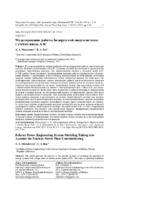| dc.contributor.author | Михалевич, А. А. | |
| dc.contributor.author | Рак, В. А. | |
| dc.coverage.spatial | Минск | ru |
| dc.date.accessioned | 2021-02-05T12:34:00Z | |
| dc.date.available | 2021-02-05T12:34:00Z | |
| dc.date.issued | 2021 | |
| dc.identifier.citation | Михалевич, А. А. Моделирование работы Белорусской энергосистемы с учетом ввода АЭС = Belarus Power Engineering System Modeling Taking into Account the Nuclear Power Plant Commissioning / А. А. Михалевич, В. А. Рак // Энергетика. Известия высших учебных заведений и энергетических объединений СНГ. – 2021. – № 1. – С. 5-14. | ru |
| dc.identifier.uri | https://rep.bntu.by/handle/data/85782 | |
| dc.description.abstract | В статье представлен анализ особенностей моделирования работы энергетических систем с большой долей мощностей АЭС. Изучение условий эксплуатации и характеристик различных энергоблоков показало, что энергетическая система с большой долей АЭС и ТЭЦ требует более детального моделирования режимов работы генерирующего оборудования. Причем с увеличением доли установок, использующих возобновляемые источники энергии, данные требования ужесточаются. Обзор литературы выявил, что чаще всего для моделирования энергетических систем используют кривую продолжительности нагрузки и ее распределения между блоками. Однако поскольку данный метод не отражает хронологическую последовательность, он может применяться только при отсутствии сложностей с обеспечением баланса мощности. Вместе с тем при высокой доле ТЭЦ и АЭС для сохранения баланса мощности необходимо знать параметры и набор включенного оборудования не только в данный момент, но и в предыдущий период, что невозможно сделать, используя кривую продолжительности нагрузки. Для моделирования необходимо использовать почасовую кривую нагрузки и рассчитывать состояние энергетической системы для каждого последующего часа в хронологическом порядке. В ходе сравнительного анализа доступных компьютерных программ выявить подходящую модель среди существующих не удалось. В статье представлена разработанная авторами математическая модель, которая позволяет моделировать работу энергетической системы с большой долей АЭС и ТЭЦ с сохранением баланса мощности для каждого часа прогнозного периода. Верификация предложенной модели показала хорошую точность используемых методов. | ru |
| dc.language.iso | ru | ru |
| dc.publisher | БНТУ | ru |
| dc.title | Моделирование работы Белорусской энергосистемы с учетом ввода АЭС | ru |
| dc.title.alternative | Belarus Power Engineering System Modeling Taking into Account the Nuclear Power Plant Commissioning | ru |
| dc.type | Article | ru |
| dc.identifier.doi | 10.21122/1029-7448-2021-64-1-5-14 | |
| local.description.annotation | The article presents the analysis of the specific features of modeling the operation of energy systems with a large share of nuclear power plants (NPP). The study of operating conditions and characteristics of different power units showed that a power engineering system with a large share of NPP and CHPP requires more detailed modeling of operating modes of generating equipment. Besides, with an increase in the share of installations using renewable energy sources, these requirements are becoming tougher. A review of the literature revealed that most often the curve of the load duration and its distribution between blocks are used for modeling energy systems. However, since this method does not reflect a chronological sequence, it can only be used if there are no difficulties with ensuring power balance. Along with this, when the share of CHP and nuclear power plants is high, to maintain a balance of power one must know the parameters and a set of powered equipment not only currently but, also, in the previous period. But this is impossible if a curve of load duration is used. For modeling, it is necessary to use an hourly load curve and to calculate the state of the energy system for each subsequent hour in chronological order. In the course of a comparative analysis of available computer programs, it was not possible to identify a suitable model among the existing ones. The article presents a mathematical model developed by the authors, which makes us possible to simulate the operation of a power engineering system with a large share of NPP and CHPP while maintaining the power balance for each hour of the forecast period. Verification of the proposed model showed good accuracy of the methods used. | ru |

